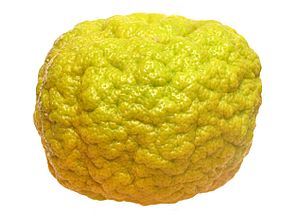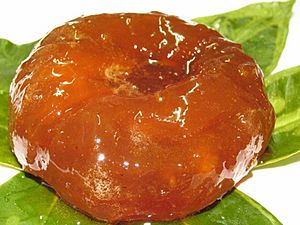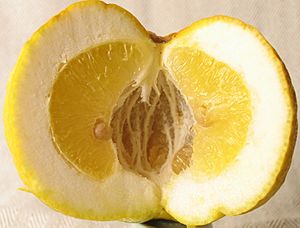Pompia facts for kids
Quick facts for kids Pompia |
|
|---|---|
 |
|
| Pompia fruit | |
| Scientific classification | |
| Genus: |
Citrus
|
| Species: |
medica tuberosa
|
| Synonyms | |
|
|

Pompia (Citrus medica tuberosa), also called pumpia or sa pompia, is a special type of citrus fruit. It is a hybrid, meaning it's a mix of two different citrus plants. People grow it for its unique and edible fruit.
Contents
Where Pompia Grows
Pompia first grew in Sardinia, an island in Italy. It is still found only there, especially in the eastern part. You can see it growing wild in citrus groves or planted in people's gardens and farms. The first descriptions of this fruit were written in 1780. It probably started growing around 1760 in a town called Milis.
What Pompia Looks Like
The pompia fruit is quite big, about the size of a grapefruit. It is usually round, but can sometimes be flat or even square. Its skin is rough and bumpy, and it's yellow when ripe. When it's not ripe, it's green. The skin is very thick and sometimes has ridges.
Sometimes, the fruit has a round dip at the top or bottom. The inside of the fruit is yellow and tastes sour. It's mostly dry and not usually eaten on its own. Some people say it tastes bitter and is chewy. The fruit has a light smell and contains 13 to 14 sections.
Pompia usually does not have many seeds, maybe 1 to 3. These seeds are small, about 8 to 12 millimeters long, and shaped like triangles. A single pompia fruit can weigh up to 1.5 pounds (0.7 kilograms).
The Pompia Tree
The pompia tree has many branches and grows about 2 to 3 meters (6.5 to 10 feet) tall. It stands upright and spreads out. The leaves are dark green and shaped like an oval. They feel tough, like leather.
Pompia flowers are white and grow alone or in small groups of 2 to 8. They usually have five petals. The tree produces fruit from October all the way to February or March.
How Pompia is Used
People in Sardinia have been growing pompia for at least 200 years. It became more famous around the world in the 1990s. This happened when a large farm of pompia trees was planted as part of a special project. Now, it is a recognized food by Slow Food, an organization that supports local and traditional foods.
The most famous use for pompia is in a traditional dessert called Sa pompia Intrea. This sweet treat comes from Siniscola. To make it, the thick skin of the fruit is candied, then covered with honey, and served on an orange leaf. Pompia is also used to make different kinds of drinks. Sometimes, pompia is grown by joining it to a sour orange tree.
Pompia's Family Tree (Genetics)
For a long time, people thought pompia was a mix of a citron and a grapefruit or a citron and a lemon. However, new studies show that pompia is actually a hybrid of the citron (C. medica) and the sour orange (C. aurantium). The citron provided the pollen, and the sour orange was the seed parent.
Scientists are not sure which exact type of citron was the parent, but it might have been a Diamante citron. Pompia is genetically similar to other citrons like Rhobs el Arsa. The fruit's skin contains substances that act as antioxidants, which are good for your body. The leaves have substances that can kill harmful bacteria, like Listeria, on food.
Pompia's Classification (Taxonomy)
In the world of plant classification, Citrus limon var. pompia is sometimes considered the same as Citrus limon, which is the common lemon.


